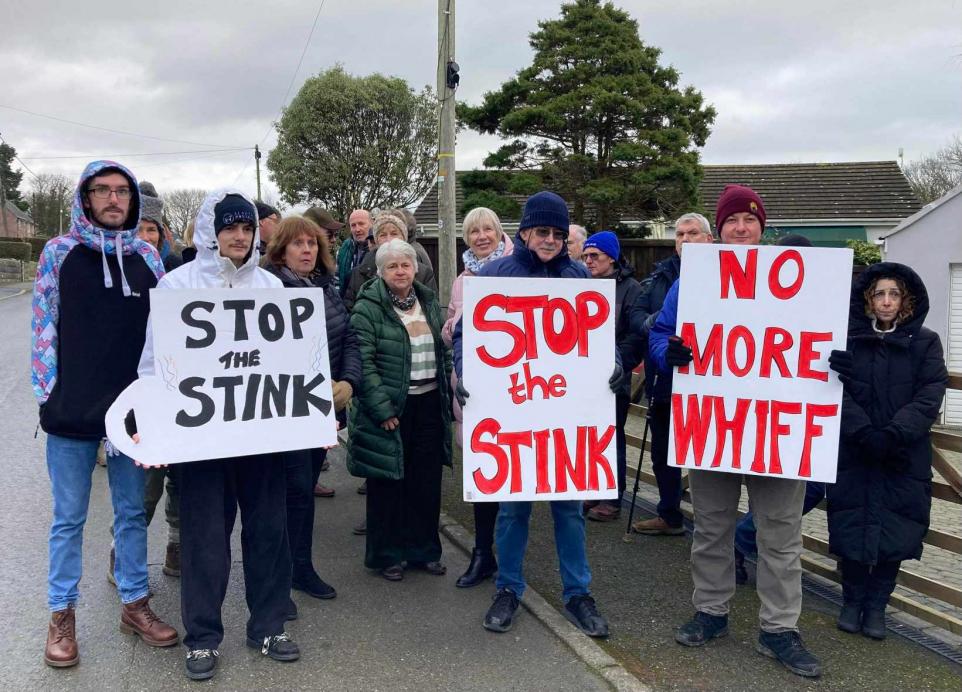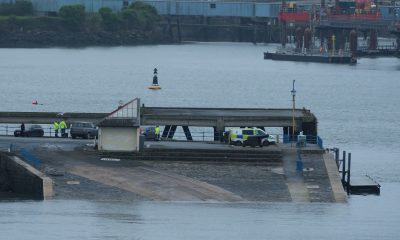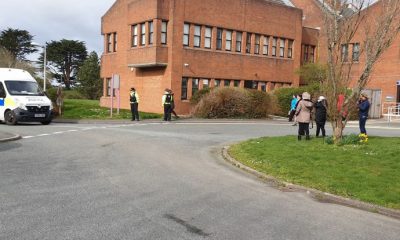News
D-Day 75: How Pembrokeshire’s beaches were used as practice for the world’s biggest invasion

By Jon Coles, Andy Chandler and Thomas Sinclair
THURSDAY (June 6) marked the 75th anniversary of D-Day, when the Allied forces landed on the beaches of Normandy, France as part of Operation Overlord; a concerted and successful attempt to liberate Europe from the grip of German occupation under Hitler.
The invasion of Normandy (codenamed Operation Neptune) was a massive amphibious assault involving 7,000 ships and 11,000 aircraft. A decoy plan, Operation Fortitude, led the Germans to believe the main target was Pas de Calais. It was a major milestone in securing victory for the allied forces.
Tenby, Saundersfoot, Amroth and Laugharne had already experienced their own version of the Normandy landings – in practice form.
Our local beaches were the location for an extensive two-week-long practice, Operation Jantzen. The exercise commenced on July 22, 1943, and was, thankfully, the only land invasion of Wales during World War II.
Under the watchful eyes of Winston Churchill and Lord Mountbatten (rumour has it that Eisenhower also attended), 100,000 American, Australian, British and Canadian forces had a rare opportunity to practice every element needed for a successful attack on “Fortress Europe”, this involved the initial landings, the setting up of Headquarters and even the moving and stockpiling of vital supplies that would be needed by troops on the front line.
Newsreel footage clearly shows trucks somehow being driven onto flat-bottomed transports in preparation for the training excercise on Tenby Beach, a beach more commonly associated with bathing, swimming and making sandcastles.

THE TROOPS
The Regimental War Chronicles of the Oxfordshire & Buckinghamshire Light Infantry Vol3 1942-1944 records that the First Bucks Battalion had been training in Ayrshire before moving to West Wales.
The road convoy of over 200 vehicles left Ayr on the July 8, 1943, and the main body departed by train three days later. Troops disembarked at Haverfordwest station, where three-ton lorries lifted them to Picton Park.
Picton Park, consisting of Nissen huts and tents, provided an excellent concentration area and preparations for Exercise “Jantzen,” due to start on the July 17, were pressed forward.
All was ready, but the exercise was postponed owing to bad weather, and the move to the assembly area at Cresselly did not begin until July 20.
The area allotted to No. 6 Beach Group consisted of the village of Saundersfoot and its immediate hinterland. There were two small beaches and a tiny port, and the country behind the beaches was hilly and heavily wooded, with narrow country lanes.
No. 5 Beach Group had an equally difficult area some miles to the east with a steep, shingle bank at the head of the beach which made exits and entrances serious problems.
The first key plan prepared before the exercise needed little adjustment and the deployment of thousands of men and hundreds of vehicles and guns proceeded most smoothly.
Coasters and barges were loaded at Tenby and beached at Saundersfoot on a falling tide.
Stores were unloaded first to barge and then to lorry, and, when the coasters had dried out, direct to lorry. Folding boats were not used and the DUKW had still not made its appearance.
On August 5 (D+14) the exercise was closed.
A great many lessons had been learned from “Jantzen.” The organisation and training of the group were sound. The complicated deployment drill had worked smoothly although it had been shown how vulnerable any beach organisation is to deterioration in the weather.
The effort was not only limited to troop movements.
The first major supply exercise involving barges (36 in 3 flotillas), 36 coasters and other forces, took place at Tenby, South Wales in July/August 1943 in Exercise “Jantzen”.
As part of the preparation for sailing across the English Channel for the Normandy landings, “dumb” Thames River barges sailed from the south coast of England around Land’s End and across the Bristol Channel under their own power.
The barges acted as kitchen vessels and troop transports during the exercise.
They subsequently made even longer coastal voyages over to Normandy as supply vessels.

All of which begs the question: Why West Wales?
The beaches of west Wales were chosen because they mimicked the conditions of Normandy being a mixture of salt flats, shingle and wide sandy areas overlooked by dunes. In addition, earlier in the war some of them had been extensively fortified and defensive measures put in place as part of the preparations for invasion.
The importance of experiencing the ‘draft’ of landing beaches was vitally important as were the changing tidal conditions around the West Wales coast.
The area’s roads were also used to give troops experience of moving along thin, rural roads with heavy armour like Tanks and Armoured Troop Carriers.
Speaking to the BBC in 2007, Bentley Howell, whose family lived at Wiseman’s Bridge Inn at the time, remembered some of the events surrounding Operation: Jantzen.
“My half-brother, who was about 40 years old, was at the time the licensee of the Wiseman’s Bridge Inn, Permbrokeshire. In his old age, he used to tell me of his wartime memories and particularly about the day that Winston Churchill called in for a pot of tea.
“A full scale invasion landing practice took place, involving up to 100,000 men, DUKW’s, other landing craft, and troopships disgorging their loads onto the sands of the Saundersfoot bay.
“The publican, John Henry Mathias, or ‘Jack the Bridge’ as he was affectionately known, was appointed a Coastguard because of his local knowledge, and although the whole area had been sealed off for security reasons and a 10pm curfew imposed, Jack was exempt from this and wandered at will.
“Officially, the troops were not allowed to drink, but for 1s 6d they had all they could eat – home killed ham, eggs, fried bread and apple tart. Jack entertained them with tales of a ghostly monk who roamed the tunnels between Saundersfoot and Wiseman’s Bridge.
“One day, several large staff cars swept down the narrow lane to the pub. It was about 3pm, but in those days the pub was open all hours. A blonde woman in an ATS uniform carried out ‘a plain Welsh tea’ to the party of about 15 high ranking officers – later it was learned that she was Sarah Churchill; Winston Churchill surveyed the troops on the beaches together with Admiral Viscount Mountbatten. It was rumoured that Eisenhower was also present”.
For several years after the War, the letter signed by Churchill, thanking the licensee for his hospitality hung on the wall in the pub premises.
In fact, the rumours about Eisenhower’s presence in Pembrokeshire were true, but not quite in the way supposed.
The late and much-missed Vernon Scott wrote in his book An Experience Shared: “Had residents been told on the first day of the fourth month of 1944 that the Supreme Allied Commander, General Dwight D Eisenhower, was in Pembroke Dock, they would have surely dismissed it as an April Fool leg pull. But America’s top soldier in the European Theatre of Operations, really was in the area.”
Eisenhower came to west Wales to inspect the men of the 110th Infantry Regiment, at that time based at Llanion Barracks in Pembroke Dock.
By April 1944, the Regiment was going through last-minute training for the Normandy landings and push for victory.
The Supreme Commander Allied Forces’ visit came as a surprise to the GIs stationed in the County. ‘Ike’ arrived in secrecy at Tenby and was whisked to Pembroke Dock in a staff car kitted out with miniature stars and stripes for the occasion.
The GIs called Pembroke Dock ‘Blitz Ville’, surprised at the extent of the bomb damage in such a small town on the far fringes of Wales.
Pembrokeshire wears its battle-scars proudly, from the huge castles built hundreds of years ago to suppress the native Welsh, to the fuel depots, RAF airfields and anti-aircraft gun bases that were literally thrown up around the county to help protect Great Britain from the power of the Nazi war machine.
The south of the county bore the brunt of Hitler’s wrath. On August 19, 1940, a fuel depot at Llanreath, Pembroke Dock, was bombed by the Luftwaffe. The resulting fire spewed thick, black, oily smoke into the blue skies of Pembrokeshire for 18 days.
The dense plume of smoke could be seen from as far away as the North Devon coast and the fire claimed the lives of 5 Cardiff-based firemen who had been sent down to help deal with the raging inferno as an estimated 100,000 gallons of oil burned.
600 German prisoners of war were also imprisoned in Pembrokeshire during the conflict, with many being placed at local farms to plough, plant and help the Allied war effort ‘dig for victory’.
Looking around today, it’s hard to imagine the full military might of the Allies being put through their paces on our beaches, but our county’s role as a staging area for the biggest naval landing in human history cannot be underestimated
Business
Steelworkers’ Union presses Tata to adopt expert plan ahead of talks

THE Steelworkers’ union, Community, is pressing Tata Steel UK to scrap its bad deal for steel and commit to the alternative Multi-Union Plan ahead of crucial talks with the company this week.
The call follows a meeting between steel unions and Tata officials last week, and the publication of a new report from industry experts Syndex which slams Tata’s approach for pursuing ‘what’s cheap’ over ‘what’s best’. The report highlights that the company’s current proposal – which would cut around 2,800 jobs in South Wales by moving production at Port Talbot to a single 3mt Electric Arc Furnace – comes with significant risks, and would make Tata Steel UK an outlier in Europe.
In contrast, Syndex describes the Multi-Union Plan as “the only solution offering to maintain all the volume currently produced by Tata Steel UK” providing “a future for all the company’s assets and a roadmap for a just transition under the constraint of the financial hurdles and the reality of market dynamics for the UK steel industry.”
Community General Secretary Roy Rickhuss said: “During our meeting with Tata last week, members of the National Trade Union Steel Coordinating Committee provided our final conclusions on the company’s restructuring proposals: namely that the company’s plan is reckless; that it weakens national security by removing Britain’s primary steelmaking capacity; and that it would have devastating consequences for steel communities in South Wales and beyond.
“Our Multi-Union Plan is a credible alternative to Tata’s destructive scheme. It would safeguard the future of Port Talbot steelmaking, protect all the downstream plants, save thousands of jobs and can be delivered with no compulsory redundancies.
“It is not too late for Tata to do the right thing and adopt the Multi-Union Plan – and we hope that they will take this step. However, should the company choose to reject it, we will fight them every step of the way. To enable us to do this, we will need the strongest possible mandate from our ongoing industrial action ballot. For that reason, I am urging all our members to vote ‘YES’ and ‘YES’ and return their ballot papers at the earliest opportunity.”
Community’s Assistant General Secretary Alasdair McDiarmid said: “Syndex’s new report demonstrates clearly that our Multi-Union Plan is viable and sustainable, whilst Tata’s proposals are reckless and harmful. The company must change course, and the UK Government need to step up too. Our alternative plan would require additional investment from the government – taking total public support for the decarbonisation of Port Talbot to £950m overall – but this is still significantly less than the support packages other governments are providing to green their steel industries. It’s also in line with the £3bn Green Steel Fund the Labour Party has guaranteed to deliver in the next parliament.
“We are at a critical moment, and the choices that Tata and the government make now will reverberate for generations to come. The fundamental question here is whether we want to be a country that makes its own steel, or a country that imports it – as would be inevitable under Tata’s damaging proposal. With the spectre of a CBAM exemption for India hanging over free trade talks, we risk under current plans becoming little more than a simple processor for imported Indian Steel. We can’t allow our industry to be sacrificed on the altar of Rishi Sunak’s search for a legacy.
“With so much at stake, we are urging our members to vote ‘YES and ‘YES’ in our industrial action ballot to enable us to fight to maintain blast furnace steelmaking into the 2030s and to prevent compulsory redundancies.”
Leading South Wales steel MPs have also thrown their support behind Community and the GMB’s Multi-Union Plan.
Stephen Kinnock, MP for Aberavon, said: “As industry experts at Syndex have laid out this week, the Multi-Union Plan is a detailed, serious, robust and compelling proposal for the future of the Port Talbot steelworks and it has my full and unequivocal support. It’s the only realistic route to retaining our customer base, and it’s also the only credible pathway to a strong, competitive and profitable future for steel-making in Port Talbot and throughout the downstream plants across Wales and the UK. By contrast Tata’s shortsighted and counter-productive plan will mean exporting jobs from Port Talbot to India, a country where steel plants have a far higher carbon footprint.
“It’s vital that steel is at the heart of a forward-looking industrial strategy, which is why Labour has pledged £3billion to support the industry over the next decade.”
Jessica Morden, MP for Newport East which includes Llanwern Steelworks, said: “Tata and Rishi Sunak’s bad deal for steel would represent a huge blow to our steel industry and steel communities like our own in Newport. The deal would also leave the UK country dependent on imported steel from heavy-polluting countries at a time of global uncertainty.
“It doesn’t have to be this way, and the Multi-Union Plan for steel which Community and GMB have put forward represents a viable alternative to protect jobs and preserve steelmaking capacity here in South Wales. I urge Tata to think again and change course from their damaging proposals.”
Business
Workplace volunteering could boost productivity and unlock billions

EXPANDING workplace volunteering opportunities to cover all employees in the UK could generate billions in economic gains (£1.2 billion – £3.6 billion per year in wellbeing benefits to individuals, £1.6 billion – £2.8 billion per year in improved net productivity)
Ensuring all employees have access to volunteering opportunities could save between 1.4 million and 2.5 million working days of sickness absence.
Workplace volunteering has the potential to boost productivity, improve employees’ wellbeing, and generate billions for the UK economy, according to a new report by Pro Bono Economics (PBE).1
The report – ‘Triple dividend: How workplace volunteering can make us happier, healthier and more productive’ – which has been produced for business volunteering charity Pilotlight, found that net productivity gains of between £1.6 billion – £2.8 billion could be unlocked for the UK economy by expanding workplace volunteering opportunities.2
PBE’s analysis revealed that 17 – 23 million employees currently do not have access to workplace volunteering, and so are missing out on the health benefits of volunteering and the opportunities to learn new skills. By expanding workplace volunteering opportunities to cover all employees in the UK, the current untapped potential could generate £1.2 billion – £3.6 billion in wellbeing benefits per year to the individuals themselves.
It could also reduce levels of absenteeism, with research showing that participation in a workplace volunteering scheme provides an average reduction in absence of around 0.9 days per year for each member of staff volunteering.3 The number of days that employees have taken off work due to illness has risen sharply since the pandemic, with 186 million lost alone in 2022, an increase of more than a third over the 2019 level. The total cost of sickness absence to UK employers was around £24 billion – roughly equivalent to the GDP generated by Newcastle – or £6.4 billion higher than if absence rates stayed at the 2019 level.4
Turning to the productivity benefit overall, the PBE report points to studies which have suggested the productivity impact of workplace volunteering is sizeable, with high-skilled individuals who volunteer experiencing an estimated £2,300 boost to earnings. If the estimated productivity increase was applied to all the 1.4 – 2.5 million additional volunteers who participated from workplace volunteering to all employees, it could provide a gross productivity increase of between £2.2 billion and £3.9 billion.
Even after deducting the costs of lost time and administration fees for volunteering schemes, the productivity benefits could amount to net productivity gains of between £1.5 billion and £2.8 billion to the UK economy.5
There is a clear appetite from employees from the expansion of workplace volunteering. Analysis by NCVO suggests that between one quarter and a third of employees will take advantage of workplace volunteering when it’s available. This means that between 1.5 million and 2.8 million additional people might volunteer if workplace volunteering schemes were expanded across all employers.
While boost workplace volunteering would have some costs to the employer, the benefits more than outweigh those costs. For the employer, workplace volunteering schemes such as those run by Pilotlight which bring businesses and charities together could deliver between £1.50 and £3.60 of benefits for every £1 spent.
To make the most of the opportunity, research by the charity has suggested that employers should take steps to help employees around the options for volunteering. More than a third of employees surveyed (38%) said that an obstacle to volunteering is a lack of guidance from their employer. Of those currently involved in workplace volunteering, 79% believe that businesses themselves benefit from the practice.6
The benefits also have the potential to positively impact on communities, at a time when they are in need of extra support. Three in ten (30%) charities reporting increased rates of staff burnout as they struggle with the triple challenge of rising demand, difficulties recruiting volunteers and challenges with recruitment. This is particularly true of small charities, with almost six in ten (59%) reporting that recruiting volunteers is a major concern for them following a long-term decline in volunteer participation rates.8
Dr Jansev Jemal, Director of Research and Policy at Pro Bono Economics, said: “Increasing access to workplace volunteering opportunities has a triple dividend, as it could boost productivity and unlock billions in the UK economy, while providing much needed support for charities. In addition to wellbeing for employees, there’s a compelling, hard-nosed business case for considering workplace volunteering, including boosts to health and skills.
“As businesses take up this opportunity, there is a need to be realistic about the challenges for the charities themselves. Using volunteers effectively takes resources to manage, oversee and support those that are giving up their time. Businesses and other funders will need to consider how they can benefit by supporting the underlying costs of volunteering programmes, rather than assuming that an offer of time alone will suffice.”
Ed Mayo, Chief Executive of Pilotlight, said: “When it comes to business and charity, these results change everything – volunteering is not a cost, it is an investment. It is good for charity, good for the volunteer and good for the bottom line.
At the heart of this, in the partnerships we have designed with a range of leading businesses, is how employees develop their skills as they deploy them in a radically different setting. In future, it will not be the PR or corporate affairs department that leads on employee volunteering, but HR leaders who see it as an integral part of their toolkit for developing talent and skills.”
Jack Kidder, Responsible Business Manager at Henry Boot PLC, said: “At Henry Boot, we know that volunteering empowers our people to dedicate their time, skills, and passion for the benefit of our communities. This is not only impactful for charities, but also hugely beneficial for our business. Volunteering their time allows our people to connect with issues they care about in the communities in which we work and live. It creates a genuine sense of purpose and cohesion as our people come together to make a real difference for others – whether through inspiring learners, supporting communities, restoring habitats, or sharing knowledge. Volunteering enables our people to develop their skills and experience the positive wellbeing effects associated with helping others. This use of our time is helping shape our evolving culture as we celebrate being a long-term sustainable business that genuinely cares for the communities we work with, while we create exciting new places across the UK.”
Alexandra Berry, Head of Sustainability at the Strand Palace Hotel said: “Our team love to get involved in team-building hikes, red nose days, wellbeing walks, ‘Wear it Pink’ days, charity runs, bingo nights, themed quizzes, clothing donation drives, as well as offering our team a paid volunteering day each year. Feedback from our team has expressed these community events provide socialisation and relaxation outside of the hotel alongside contribution to a charitable cause, of which they are passionate about supporting.
“In 2023, the team raised over £3,000 through 8 local fundraising activities. What’s more, we have a regular commitment with The Connection at St Martins for our team members to volunteer to spend time with The Connection’s guests in their art room. With arts, crafts and chatting, the visits from the Strand Palace team help to build the guests’ confidence and social skills, providing a creative outlet away from the stress of being homeless.”
Health
Pembrokeshire residents suffer severe health decline ‘due to landfill gases’

A PEMBROKESHIRE couple, Mr Richard and Revd Patricia Rogers of Crud yr Awel, are experiencing severe health issues attributed to emissions from the Withyhedge Landfill, resulting in drastic lifestyle changes and severe symptoms.
Revd Rogers, who has managed asthma since childhood, reported a significant deterioration in her condition following exposure to landfill gases. Despite having controlled her asthma with minimal medication for years, she now requires intensive treatment including increased doses of Symbicort and Salbutamol Sulfate inhalers, alongside courses of steroids and antibiotics. Her symptoms have escalated to include extreme breathlessness, a hacking cough, frequent nosebleeds, continual headaches, and vertigo, culminating in a severe impact on her ability to perform daily tasks and care for her disabled daughter.
The couple’s health is closely monitored through their doctor’s surgery, and they attend the asthma clinic regularly. However, feeling powerless to directly change the situation, they have taken a stand by cancelling their council tax payments, a decision they plan to maintain until the landfill issue is resolved.
Revd Rogers has also prepared a letter to the Coroner, outlining the severity of her health issues as potentially life-threatening due to the landfill’s impact. This dramatic step underlines the gravity of their situation and their desperation for a resolution.
The Rogers’ story is not just a personal tragedy but a stark example of the broader environmental and health challenges faced by the community surrounding the Withyhedge Landfill.
They are calling for punitive measures against those responsible, including compensation for the financial impacts of their ordeal.
Their story has surfaced on the same day we reported that Natural Resources Wales is taking further enforcement action against the firm running the site.
NRW has issued site operators Resources Management UK Ltd (RML) with a further Regulation 36 Enforcement Notice which requires the operator to deliver a series of actions by specified deadlines to address ongoing smells from the landfill.
You can read more about the Enforcement Notice on the NRW website.
Outgoing Council Leader, Cllr David Simpson, said in a statement this week: “The smell from Withyhedge is having a major impact on residents and visitors. This situation has gone on too long and it is unacceptable.
“We now need to see RML act on the demands of the Notice and within the deadlines.
“The Council fully backs NRW’s stance that nothing is off the table in terms of further enforcement, including suspending the site’s environmental permit if appropriate, and we remain committed to working with NRW to ensure a long term solution to these issues.”
-

 News6 days ago
News6 days agoPolice issue update on the search for Luke, missing from Pembroke Dock
-

 News20 hours ago
News20 hours agoPolice and air ambulances at ‘serious incident’ at West Wales school
-

 Sport7 days ago
Sport7 days agoHerbrandston Clinch Promotion to Division One
-

 News5 days ago
News5 days ago20mph U-turn: Some roads will return to 30mph following public outcry
-

 Community5 days ago
Community5 days agoMiracle pup finds her forever home after heart-wrenching journey
-

 Community2 days ago
Community2 days agoCounty Hall to offer space for community banking
-

 Crime3 days ago
Crime3 days agoBrian Davis: Wanted on suspicion of commercial burglary
-

 Crime20 hours ago
Crime20 hours agoPembrokeshire pensioner accused of 17 sexual offences against children




































